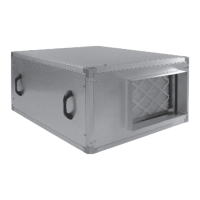
Do you have a question about the NuAire ESBH Series and is the answer not in the manual?
| Model | ESBH Series |
|---|---|
| Energy Efficiency Ratio (EER) | Varies by model and configuration |
| Dimensions | Varies by model |
| Weight | Varies by model |
| Insulation | 1" coated fiberglass insulation |
| Motor Type | ECM |
| Voltage Options | 208/230V |
| Heating Options | Electric, hot water |
| Cooling Options | Chilled water coil, DX coil |
| Cooling Capacity | Varies by model and configuration |
| Heating Capacity | Varies by model and configuration |
Explains the coding system for Nuaire Ecosmart Boxer Ventilation Units.
Units size 3+ are modular; installer responsible for assembly and wiring.
Control boxes are on external casing for units size 3 and above.
Describes typical unit arrangements for direct drive models, sizes 1 and 2.
Describes typical unit arrangements for belt drive models, sizes 3 to 7.
Guidance on correct sling positioning and observing the centre of gravity during lifting.
Details on erecting single section units (sizes 1-2) and multi-section units (sizes 3-7).
Instructions for mechanical assembly of sections using provided fixing kits.
Guidance on connecting inter-connecting wiring looms between modules.
Recommendations for installing the unit indoors on a secure, level surface.
Guidelines for external installation, including using the base frame and weather roof.
Details on wet pipe connections for coils, including BSP sizes.
Table detailing power requirements (FLC) for various unit models.
Wiring diagram for specific ESBH unit models.
Notes on Ecosmart controls, heater output, voltage drops, and inverter settings.
Important note regarding adjacent modules and connection to Ecosmart control.
Important note regarding actuator and sensor connections to the Ecosmart control.
Important note regarding actuator and sensor connections to the Ecosmart control.
Guidance on sizing and terminating mains cables for unit connections.
Details on 'Net' plug-in connectors for sensors, controls, and fan linking.
Information on the Switched Live terminal for fan activation and over-run.
Details on connecting dampers, including OP, CL, N, and RET terminals.
Information on volt-free relay contacts, their ratings, and functions.
Guidelines for installing SELV data cables, separation, and maximum run lengths.
Specifies the maximum number of devices that can be connected together.
Principles for installing other low voltage cables, keeping runs short.
How to make BMS connections using a plug-in connector.
Electrical setup procedures including test button, LED indicators, and airflow settings.
Mechanical setting to work procedures, including flow valve setting and frost protection.
Recommended intervals for maintenance tasks, starting at three months after commissioning.
Motors are fitted with sealed-for-life bearings and require no lubrication.
Instructions for cleaning and inspecting the fan unit, controls, and interior.
Checks for tight fixings, sealing strips, and duct connections.
Guidance on changing disposable filters and washing washable filters.
Procedures for cleaning control box interiors and checking components.
Method for checking and adjusting drive belt tension for sizes 3-6.
Step-by-step instructions for replacing a drive belt.
Method for adjusting drive belt tension for Size 7 units.
Detailed steps for checking belt tension on Size 7 units.
Information on ordering spare parts and the required unit information.
Section for manufacturer representative signatures, names, and dates.
General statement about the equipment being supplied by Nuaire for assembly into a system.
Details on documentation provided with the equipment, including data sheets and rating plates.
Guidance on safe handling, storage, and protection of equipment.
Specifies operational limits such as air temperature, contaminants, and orientation.
General installation requirements, including guarding and electrical safety.
Pre-commissioning checks, electrical safety, and security of components.
Requirements for access panels during operation and handling of equipment failures.
Importance of using correct tools and following specific maintenance procedures.
